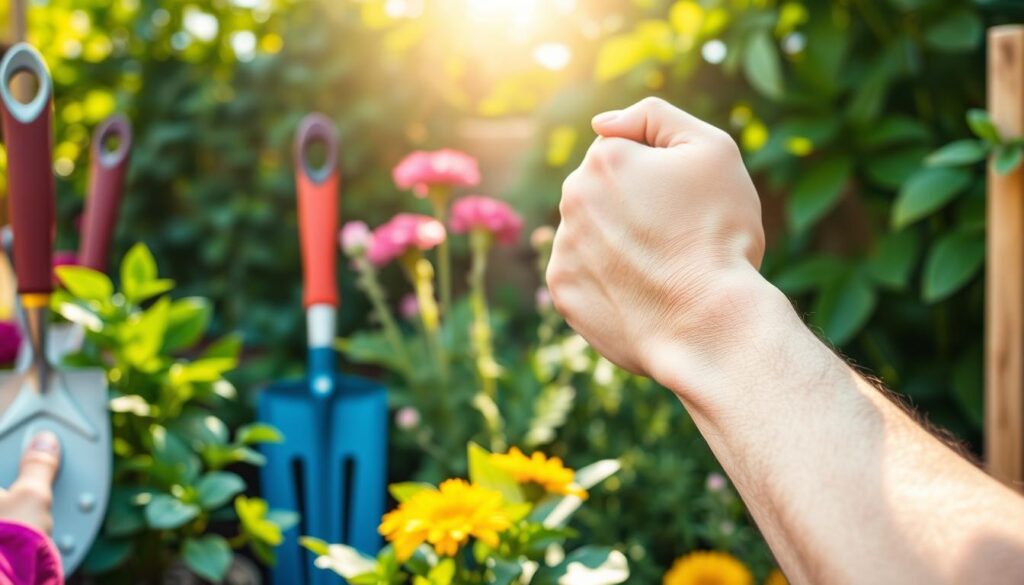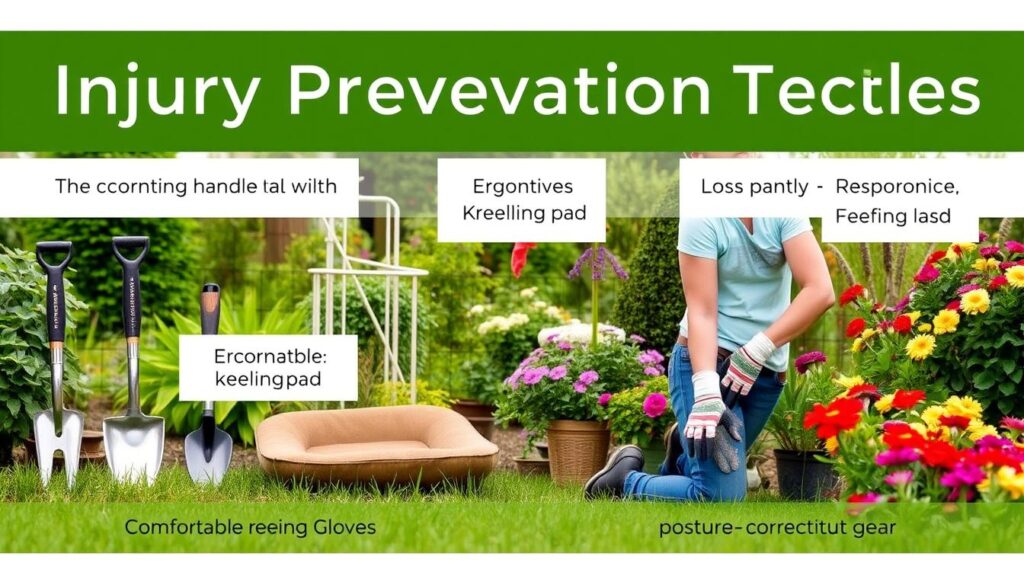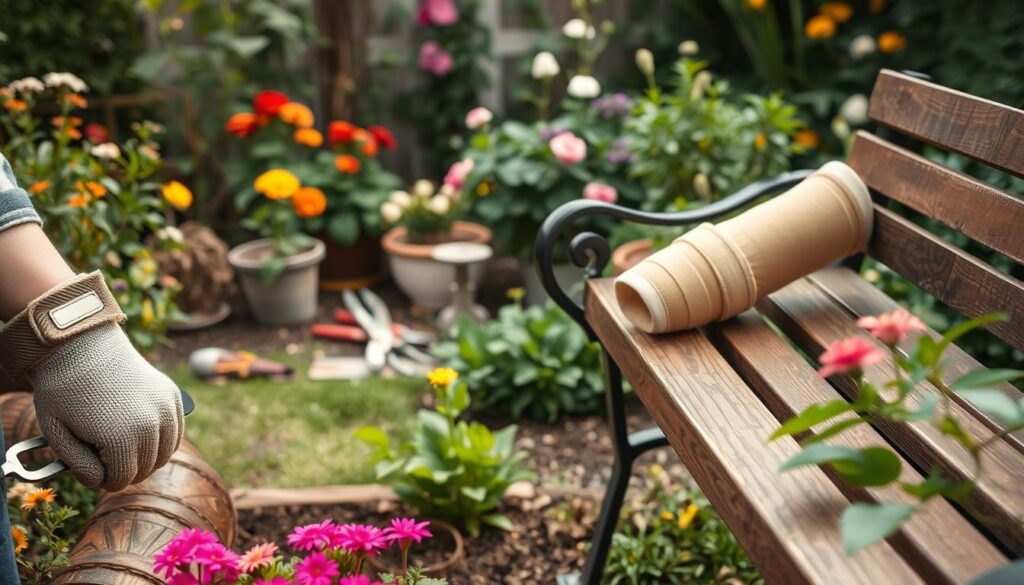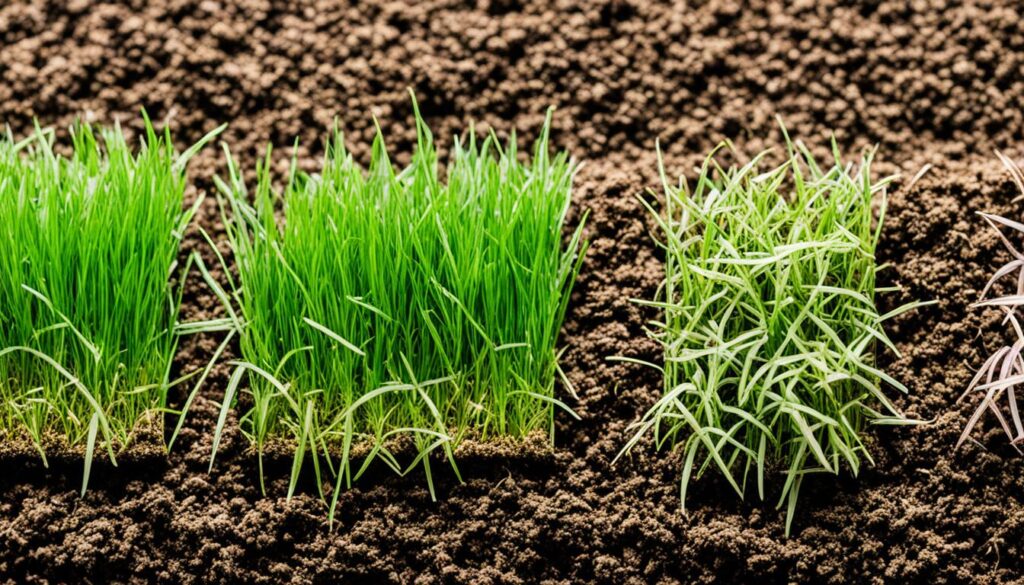Did you know over 50% of gardeners suffer from elbow pain? This fact shows how common it is for gardeners to face this issue, especially during busy seasons. Activities like digging, pulling, and gripping can lead to tennis elbow and golfer’s elbow. These conditions are often overlooked but are important to consider.
I will look into whether gardening can cause tennis elbow and what activities might lead to this pain. Let’s explore this topic together.
Key Takeaways
- Gardening activities contribute significantly to elbow pain, with a notable prevalence of injuries among gardeners.
- Repetitive strain injuries occur primarily due to tasks like lifting heavy objects and continual gripping.
- Symptoms of Gardener’s Elbow include pain, stiffness, and difficulty gripping, similar to those seen in tennis elbow.
- Proper tool selection and ergonomic practices can help mitigate the risk of developing elbow injuries.
- Rest and targeted treatments are essential for recovery from gardening-related elbow pain.
- Consulting with a physiotherapist can provide personalized approaches to prevent and manage elbow pain.
The Connection Between Gardening and Tennis Elbow
Gardening can lead to elbow pain due to physical strains. Many gardeners suffer from elbow pain, often from repetitive strain or overuse. Activities like lifting heavy soil, digging, or using tools put stress on the elbow tendons.
Less than 5% of tennis elbow cases come from tennis. Gardening is a big cause of this condition. Tasks like pruning or using shears strain the tendons, leading to elbow pain and inflammation.
Tennis and golf elbow are often caused by overuse, and gardening is a big part of that. Gripping tools or pushing a wheelbarrow can cause muscle fatigue and inflammation. Early signs include swelling, which can turn into chronic pain like tendinosis if not treated.
It’s important to know how gardening affects elbow pain for garden lovers. Understanding this can help prevent and treat these issues. This way, you can enjoy gardening without getting hurt.
Understanding Tennis Elbow and Related Conditions
Tennis elbow, also known as lateral epicondylitis, is a common injury. It happens when the tendons on the outer elbow get inflamed. People between 30 and 50 years old often get it. They might feel elbow stiffness, pain when gripping, and even wrist pain.
This condition comes from doing the same motion over and over. It usually happens when the wrists and arms are used a lot.
What is Tennis Elbow?
Tennis elbow causes pain and tenderness on the outside of the elbow. Many activities, not just tennis, can lead to it. Using the elbow wrongly or doing repetitive tasks like gardening can increase the risk.
With early treatment like rest, physical therapy, or using a brace, the pain can lessen. This helps with recovery.
Differences Between Golfer’s Elbow and Tennis Elbow
Golfer’s elbow and tennis elbow are both tendinitis but in different spots. Golfer’s elbow is on the inner side and has its own set of symptoms. Knowing the difference helps in finding the right treatment for elbow injuries.
Signs and Symptoms of Tennis Elbow
Feeling pain in your elbow can often mean you have tennis elbow. Knowing the signs of tennis elbow helps spot the problem early. This is the first step towards getting better.
Common Warning Signs to Watch For
Look out for these common signs of tennis elbow:
- Soreness or stiffness around the elbow, especially after activity.
- Burning or stabbing pain that spreads down the forearm or into the wrist.
- Weakness in grip strength, making it hard to hold things firmly.
- Increased discomfort during repetitive tasks or sports.
How to Identify Elbow Pain
Elbow pain can show up in different ways, especially with tendinitis symptoms. Knowing how to spot this pain is key to managing it:
- Assess the location of the pain. Is it mainly on the outer elbow side?
- Observe the duration of symptoms. Does the pain stay or come and go?
- Consider factors that aggravate the pain, like typing, gardening, or lifting.
- Note any swelling or tenderness when pressing on the elbow.
Tennis elbow is common among people aged 35 to 54. It can last for months but getting treatment early helps with recovery. Many people get better with physical therapy, which includes exercises and ultrasound. For those who don’t get better, surgery is an option, showing why catching it early is crucial.
| Symptoms | Impact on Daily Life |
|---|---|
| Soreness or stiffness | Limits ability to perform tasks that require arm movement |
| Burning or stabbing pain | May interfere with activities like gardening or sports |
| Weakness in grip | Challenges in holding tools or objects securely |
| Increased discomfort with repetition | Need to modify activities or take breaks more frequently |
Can Gardening Cause Tennis Elbow?
Tennis elbow is not just for athletes; it can happen to anyone who does repetitive tasks. Many wonder, can gardening cause tennis elbow? Yes, it can. Gardening activities like digging and pruning can strain the elbow tendons over time. Activities like lifting heavy pots and using tools that need gripping are common culprits.
This leads to many gardeners feeling elbow pain. Research and stories from gardeners show that gardening can cause tennis elbow. Activities like digging, weeding, or pruning can put you at risk. These actions can cause inflammation and pain in the elbow.

If you don’t take steps to prevent it, elbow pain can get worse. It can turn a day in the garden into a painful experience. Knowing how gardening activities relate to tennis elbow is key for gardeners. Using proper lifting techniques and taking breaks can help prevent and manage pain.
Common Gardening Activities That Lead to Elbow Pain
Gardening can be rewarding but also risky for elbow pain. Certain tasks put a lot of strain on the elbow joint. Lifting heavy objects, doing repetitive motions, and gripping often are big contributors.
Lifting and Carrying Heavy Objects
Lifting heavy pots, bags of soil, and other garden items can be tough on the elbow. It puts a lot of stress on the joint, leading to inflammation and pain. This pain can be mild or severe, making daily activities hard.
Repetitive Motions in Weeding and Pruning
Weeding and pruning involve a lot of repeated actions. These actions can lead to Gardener’s Elbow. The muscles in the forearm connected to the elbow can get inflamed. Over time, these motions can cause pain and make gardening less enjoyable.
Frequent Gripping and Squeezing
Using tools for a long time, like gripping a trowel or squeezing pruners, puts extra pressure on the elbow tendons. This can make existing issues worse. Over time, it may cause lasting inflammation and damage to the tendons, making gardening harder.
To avoid these risks, it’s good to take preventative steps. Warming up, using ergonomic tools, and taking breaks can help. If you’re already experiencing symptoms, seeing a doctor can help with specific advice and solutions. For more tips and information, check out this resource.
Why Repetitive Strain Injuries Occur
For gardeners, knowing why repetitive strain injuries (RSIs) happen is key. Bad posture and staying in awkward positions can lead to muscle tension. This tension can cause adhesions, which limit movement and increase the risk of forearm pain and other problems.
Understanding Muscle Tension and Adhesions
Gardening often involves repetitive motions that can cause muscle tension. This tension is not just a short-term issue; it can turn into more serious problems if ignored. Over time, gardening can create adhesions in the muscles. These adhesions limit movement and can cause a serious repetitive strain injury, making even simple tasks painful.
The Role of Tendon Damage in Elbow Pain
Gardening can also lead to tendon damage in the elbow. The repetitive motions, especially when done for a long time, put a lot of strain on tendons. This gradual damage can cause conditions like tennis elbow. I’ve had forearm pain from these issues, showing how ongoing activities can cause lasting harm.

| Factor | Description |
|---|---|
| Muscle Tension | Excessive strain from repetitive movements can lead to tightness and discomfort in the muscles. |
| Adhesions | Restrictive bands of tissue that form due to muscle tension; these can limit range of motion. |
| Tendon Damage | Continuous stress on tendons can result in inflammation and prolonged pain. |
| Forearm Pain | Pain in the forearm is often a direct indication of underlying issues related to RSIs. |
Gardening Injuries and Treatment Options
Gardening can be rewarding but also physically demanding. It often leads to elbow injuries like tennis elbow. Knowing how to treat these injuries helps manage pain and aid in recovery.
Immediate Steps to Treat Elbow Pain
When I feel elbow pain, the first steps I take are crucial for recovery. Rest is key, letting my muscles and tendons heal from strain. I avoid activities that could irritate the area.
Applying ice packs for 15-20 minutes several times a day helps reduce swelling. But, I don’t ice for more than three days to keep blood flow going. A compression brace, like the EpiTrain Elbow Brace, supports my elbow and reduces swelling, helping with injury management.
Long-Term Management and Rehabilitation
After the initial discomfort, I focus on long-term rehabilitation. Exercises like Golfer’s Elbow Stretch and isometric wrist flexion help with healing. Getting advice from a physiotherapist is very helpful; they tailor my treatment and check on my progress.
As I get back to gardening, wearing elbow support and slowly increasing my activity is key. Taking breaks and using ergonomic tools also helps reduce strain on my elbows. This way, I can garden without pain. For more on treating elbow injuries, I look at effective tennis elbow treatment techniques.
Injury Prevention Techniques for Gardeners
As a gardener, it’s key to prevent injuries. Gardening can strain my joints and muscles. By using certain strategies, I can lower the risk of getting hurt and enjoy gardening more. Here are some tips to help:
Warm-up Exercises Before Gardening
Starting with warm-up exercises helps prevent injuries. These exercises get my muscles and joints ready for gardening. Simple stretches or light exercises improve flexibility and circulation, helping avoid overdoing it. Here are some exercises I find helpful:
- Wrist circles to loosen the forearms
- Shoulder rolls to relieve tension
- Leg stretches for better circulation
These exercises are great for preventing strain in areas like my elbows and wrists. Just a few minutes of warming up can greatly reduce the risk of injury.
Choosing the Right Tools for Comfort
The tools I use in the garden are key to my safety and comfort. Choosing ergonomic tools helps prevent injuries. Look for tools with:
- Soft, cushioned grips that minimize vibration
- Adjustable handles for my height and reach
- Lightweight materials to avoid overexerting myself
Using proper lifting techniques, like bending my knees and keeping the load close, also protects my joints. Taking breaks during long gardening sessions helps prevent chronic injuries. By choosing the right tools and methods, I can garden safely and enjoyably.

When to Seek Professional Help for Elbow Pain
Knowing when to get help for elbow pain can make a big difference in getting better. It’s important to know when to see a physiotherapist for tennis elbow treatment. If you have pain, swelling, or your arm feels weaker, it’s time to get help. These signs mean you might need a doctor’s check-up.
Signs That You Should Visit a Physiotherapist
If you notice any of these symptoms, it’s a good idea to see a professional:
- Constant pain: Pain that doesn’t go away with simple home treatments.
- Swelling: Your elbow getting bigger and not going back to normal after you rest and ice it.
- Weakness: Your grip getting weaker or having trouble with everyday activities.
- Limited range of motion: Your elbow not moving easily or hurting when you try to move it.
What to Expect During a Consultation
When you see a physiotherapist, they will check your elbow carefully. They will do tests to see how bad the injury is and what’s causing it. They might suggest:
- Manual therapy: Techniques they do by hand to help with pain and get you moving better.
- Exercise therapy: Exercises made just for you to help strengthen and stretch your elbow.
- Postural education: Tips on how to stand and move to avoid putting strain on your elbow while gardening.
Using tools like the EpiTrain Elbow Brace can help your recovery by easing strain on the injured area. Adding ice and heat therapy and doing exercises as suggested can also help with healing. For more info on how to treat gardeners elbow, check out an expert’s advice here.
How to Recover and Get Back to Gardening
Recovering from elbow injuries takes time. Gardening needs a careful approach to avoid more injuries and make a lasting return. A gradual return to gardening means planning and following key practices.
Gradual Return to Activity
Coming back to gardening after an elbow injury is key. Start with easy tasks to avoid putting too much strain on the injured tendon. Here are some tips for a smooth return:
- Begin with short, less demanding gardening sessions.
- Incorporate gentle stretching exercises to enhance flexibility.
- Focus on using ergonomic tools that limit strain on my elbow.
- Gradually increase the intensity and duration of my gardening work.
These steps help me recover from elbow injuries and let me enjoy gardening again.
Ongoing Maintenance to Prevent Recurrences
Looking after my elbow doesn’t stop once I start gardening again. It’s important to keep caring for my elbow to avoid future injuries. Here are some ongoing practices I should follow:
- Perform regular strengthening exercises to improve the resilience of my elbow.
- Apply ice to the area after extended sessions to reduce inflammation.
- Wear elbow support during activities to provide additional protection.
- Schedule periodic breaks during gardening to prevent fatigue.
By focusing on ongoing maintenance, I can keep my elbow healthy and enjoy gardening without worrying about getting hurt.
Conclusion
Many of us might not think about it, but can gardening cause tennis elbow? Yes, it can. Activities like gripping, lifting, and twisting can lead to this painful condition. If you feel pain on the outer elbow or find it hard to grip things, you might have tennis elbow.
Learning about elbow health has shown me how important it is to prevent tennis elbow. Using the right techniques, not overdoing it, and stretching can help a lot. If you want to learn more about treatments like physical therapy, rest, and using a splint, check out this guide.
Enjoying my garden shouldn’t hurt my elbow. By being careful with how I garden and taking care of my elbow, I can keep gardening without getting tennis elbow. Always remember to garden safely to protect your elbow and your green thumb!
FAQ
Can gardening really cause tennis elbow?
Yes, gardening can cause tennis elbow. This happens from tasks like digging, pruning, and carrying heavy items. These actions stress the elbow’s tendons, leading to *elbow pain* and *repetitive strain injuries*.
What are the main symptoms of tennis elbow?
Symptoms include *stiffness*, *soreness*, and a *burning or stabbing pain* in the elbow, *forearm*, or *wrist*. You might also feel weak in your grip and struggle with repetitive tasks.
Is tennis elbow the same as golfer’s elbow?
No, they are not the same. Tennis elbow (lateral epicondylitis) affects the outer elbow. Golfer’s elbow (medial epicondylitis) affects the inner elbow. Knowing this helps with the right treatment.
How can I prevent tennis elbow from gardening?
To prevent tennis elbow, start with *warm-up exercises* before gardening. Use ergonomic tools that reduce strain on your elbows and wrists. This helps lower the risk of *gardening injuries*.
When should I seek professional help for elbow pain?
See a physiotherapist if you have ongoing pain, swelling, or a big drop in arm strength. Early help can stop more *elbow injuries*.
What immediate treatments can I apply for elbow pain?
For elbow pain, rest the elbow, use ice to lessen swelling, and avoid actions that make it worse. This helps with recovery from *tendinitis*.
What gardening activities should I be cautious about?
Watch out for activities like *lifting heavy objects*, repetitive *weeding and pruning*, and frequent *gripping or squeezing*. These can stress your elbows over time.



